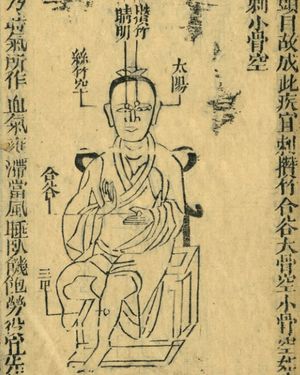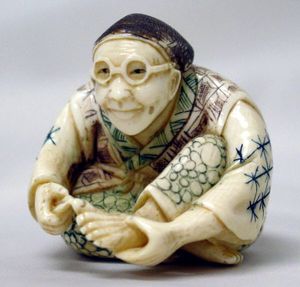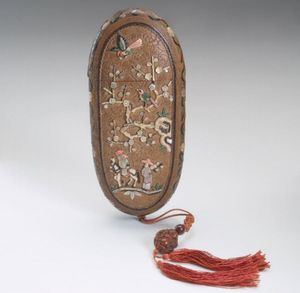Visit the Museum of the Eye at Booth 704 to see “History of Ophthalmology in the Asia-Pacific,” an exhibit about the ancient roots of ophthalmology found in Asia. Because AAO 2016 is held in conjunction with the Asia-Pacific Academy of Ophthalmology, the museum is taking this opportunity to celebrate this unique ophthalmic heritage largely unknown in the West. The exhibit features 8 display cases containing a total of 37 items from India, Japan, China, Sri Lanka, and the Philippines, including the 3 that are highlighted below.
Check out Monday’s history symposium. Learn more about the fascinating history of ophthalmology in the Asia-Pacific region at “Giants in Asia-Pacific Ophthalmology” (Sym34). Speakers from Australia, China, Japan, and South Korea will discuss ancient practitioners, early modern legends, great discoveries, and innovations.
Fu’s Precious Book of Ophthalmology
A 17th century depiction of the theories of ophthalmology, this encyclopedic account by Fu Renyu, about whom little is known, contains almost 20,000 characters and was the main reference work in the field from the time it was published in 1644 until well into the 18th century—and it is still in print. The 3 volumes were compiled and edited by Fu’s son, Fu Guodong, and his son-in-law, Zhang Wenkai. The books include detailed case studies, practical drawings for 108 eye diseases, and more than 300 prescriptions. Fu begins by describing and illustrating the eye and its components, then depicts several surgical procedures, such as the removal of cataracts. The book also includes sections on acupuncture (including the elements of wood, fire, earth, metal, and water), moxibustion, cataractopiesis (couching) with a golden needle, the 8 regions of the whites of the eyes, the theory of 5 orbiculi, and the relationship between the eyes and Zang-Fu channels and collaterals. Fu also describes eye ointments and medicines that can be used externally.

FUSHI YANKE SHENSHI YAOHAN (FU’S PRECIOUS BOOK OF OPHTHALMOLOGY), CHINA, 1644. This illustration is from a 3-book set from the Ming Dynasty that includes diagnoses for 108 eye diseases along with both surgical and nonsurgical treatment options.
Netsuke
In earlier centuries, Japanese men and women wore a traditional article of clothing called a kimono. Kimonos had no pockets, so the Japanese hung cases or purses called sagemono from their belts (known as obi). To secure the sagemono, small carved toggles, or netsuke, were used. Netsuke came in a large variety of shapes and materials, mostly ivory or wood. The 2 parts of the word—“ne” + “tsuke”—mean “root” and “to attach.” While these fasteners began as utilitarian and functional objects, they evolved over time to become artistic creations with remarkable craftsmanship, including elaborate carving and lacquering using exotic and rare materials such as coral, whale bone, and tiger teeth. Netsuke can include mundane objects from daily life, such as the one pictured, or even depictions of gods, myths, and religious symbols. Toward the end of the 19th century, netsuke use began to decline as Japanese people began to make the transition to Western clothing. However, netsuke production continued—and it continues today—as they are viewed as valuable works of art around the world.

NETSUKE, JAPAN, 19TH CENTURY. The netsuke in the Museum of Vision’s collection all have one thing in common: eyeglasses.
Spectacle Case: Three Kingdoms
Three Kingdoms, by Luo Guanzhong, is an epic novel of classical Chinese culture. This historical and also mythical story is set in the volatile years in the waning of the Han dynasty and ends with the reunification of the country in 280 CE. The tale describes hundreds of characters but focuses mainly on the 3 kingdoms vying for control of China during this turbulent time. The novel spans almost 100 years and details personal plots, military battles, and more during this tripartite struggle. Three Kingdoms contains 800,000 words and 120 chapters, and it has been named one of the Four Great Classical Novels of Chinese literature—indeed, its regional influence has been compared to that of Shakespeare. On this spectacles case, the character Ju-Gurliang is treading through the snow in pursuit of the plum flower. Attached to the case are rust-colored tassels, a small carved Buddha, a stone bead, and an endless knot, which is one of 8 significant Buddhist symbols along with the conch, fish, lotus, parasol, vase, dharmachakra, and victory banner.

SPECTACLES CASE, CHINA, 1780. This spectacles case made of sandalwood with semiprecious stone inlay depicts a scene from the 15th-century book Three Kingdoms, by Luo Guanzhong.
Did You Know?
- Sushruta Samhita, written by Maharshi Sushruta in 600 BCE India, includes the world’s first description of cataract surgery.
- The first medical school in China was established by the T’ang Dynasty in 624 CE.
- An archeological site in Sri Lanka dating to 800 CE holds the world’s oldest evidence of a hospital.
- The Majima School of Ophthalmology in Japan, founded in 1357, kept its teachings a secret, letting students copy only 1 scroll as a memory device.